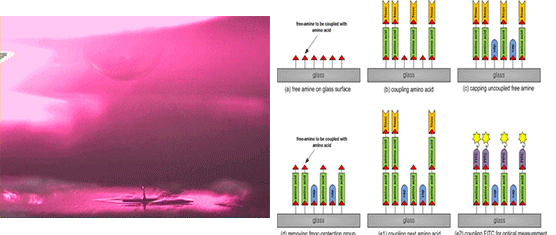Youngki Choe, Shih-jui Chen, and Eun Sok Kim, University of Southern California
Volume: 61, Issue: 3, Page:705-710

This paper describes our recent synthesis of glycine peptides with various molecular lengths (1 – 9 mers) on a modified glass surface using an acoustic droplet ejector and SPOTTM peptide synthesis protocol. Usage of an acoustic droplet ejector (based on silicon Fresnel lens) reduced the spot size for peptide synthesis through dispensing nanoliter droplets of pre-activated amino acid solution on photo-lithographically defined active spots (1 mm in diameter) on a glass substrate where the dispensed liquid keeps its spot boundary with minimal spreading. The stepwise coupling yield was measured to be 96%, and the final yield of a 9-mers-long peptide synthesis was measured to be 70% when estimated from light intensity coming from FITC fluorescent tag.
Solid phase peptide synthesis (SPPS) has been used in synthesizing peptides for decades and achieved very high yield. However, SPPS is not suitable for peptide synthesis on a solid surface for peptide microarray. SPOTTM technique, based on same chemical basis with SPPS, allows parallel synthesis of different peptide sequences on multiple spots on a solid surface, but has relied on a liquid dispensing technique that is bulky, imprecise in volume control, and not easily scalable. Through this paper, we demonstrate that SPOTTM technique can be innovated with a MEMS-based acoustic droplet ejector that is scalable, and is capable of dispensing liquid with precise volume control and placement accuracy. Thus, we have shown a pathway to massive parallel synthesis of peptide array on a solid surface with minimal amounts of amino acids.

